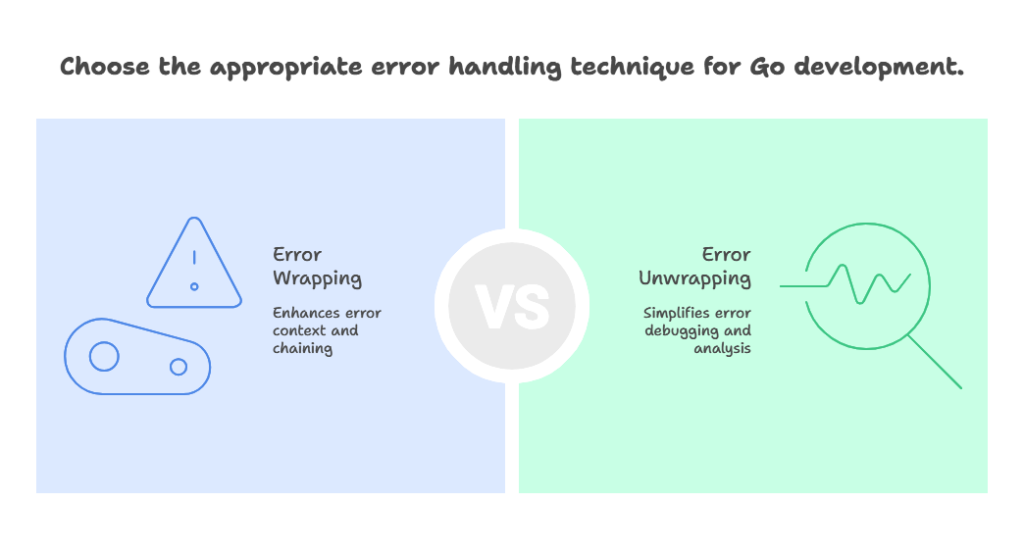Error Wrapping and Unwrapping in Go
Error handling is a critical aspect of programming, ensuring that programs gracefully handle unexpected situations. In Go, errors are represented by values of the error interface type. This chapter delves into the concept of error wrapping and unwrapping, a powerful mechanism provided by the errors package in Go, facilitating the propagation of errors with contextual information.
Understanding the Basics of Error Wrapping
In Go, error wrapping allows developers to augment errors with additional context, making it easier to understand the cause of an error. The errors.Wrap() function from the github.com/pkg/errors package is commonly used for this purpose. Let’s illustrate this with an example:
package main
import (
"fmt"
"github.com/pkg/errors"
)
func process() error {
// Simulate an error
return errors.New("something went wrong")
}
func main() {
err := process()
if err != nil {
wrappedErr := errors.Wrap(err, "failed to process data")
fmt.Println("Error:", wrappedErr)
return
}
fmt.Println("Process completed successfully")
}
- The code imports the necessary packages: “fmt” for formatting and printing, and “github.com/pkg/errors” for error handling.
- The
process()function is defined to simulate an error by returning an error instance created usingerrors.New()with the message “something went wrong”. - In the
main()function,process()is called and the returned error is checked for non-nil. - If an error is returned, it’s wrapped with additional context using
errors.Wrap(), adding “failed to process data” as a prefix to the original error message. - The wrapped error is printed using
fmt.Println(). - If no error occurs (i.e., the error is nil), it prints “Process completed successfully” indicating successful completion of the process.
- The approach of error wrapping with additional context helps in better understanding and debugging errors by preserving the original error message while providing more information about the context in which the error occurred.
- This demonstrates a common pattern in Go for error handling, where errors are wrapped with contextual information for better traceability and debugging.
Error Unwrapping for Error Inspection
Error unwrapping in Go involves extracting the original error from a wrapped error. This can be useful when inspecting errors or handling specific error cases. The errors.Cause() function is utilized for unwrapping errors. Let’s demonstrate this with an example:
package main
import (
"fmt"
"github.com/pkg/errors"
)
func process() error {
// Simulate an error
return errors.New("something went wrong")
}
func main() {
err := process()
if err != nil {
// Unwrap the error to get the original cause
originalErr := errors.Cause(err)
fmt.Println("Original Error:", originalErr)
return
}
fmt.Println("Process completed successfully")
}
- The code imports the necessary packages: “fmt” for formatting and printing, and “github.com/pkg/errors” for error handling.
- The
process()function is defined to simulate an error by returning an error instance created usingerrors.New()with the message “something went wrong”. - In the
main()function,process()is called and the returned error is checked for non-nil. - If an error is returned, it is unwrapped using
errors.Cause(), which retrieves the original cause of the error. - The original error is then printed using
fmt.Println(). - If no error occurs (i.e., the error is nil), it prints “Process completed successfully” indicating successful completion of the process.
- This approach of error unwrapping allows accessing the original error cause, which might be useful for logging or handling specific error conditions.
- While error wrapping provides additional context, error unwrapping allows accessing the root cause of the error for more detailed analysis or specific error handling.
Chaining Errors for Enhanced Debugging
Error wrapping enables the chaining of errors, providing a detailed trace of error propagation. This is particularly useful for debugging complex systems where errors may traverse multiple layers of abstraction. Consider the following example:
package main
import (
"fmt"
"github.com/pkg/errors"
)
func process() error {
// Simulate an error
return errors.New("something went wrong")
}
func intermediate() error {
err := process()
if err != nil {
return errors.Wrap(err, "error in intermediate")
}
return nil
}
func main() {
err := intermediate()
if err != nil {
fmt.Println("Error:", err)
return
}
fmt.Println("Process completed successfully")
}
- The code imports the necessary packages: “fmt” for formatting and printing, and “github.com/pkg/errors” for error handling.
- The
process()function is defined to simulate an error by returning an error instance created usingerrors.New()with the message “something went wrong”. - An
intermediate()function is introduced, which callsprocess()and wraps any error returned with additional context usingerrors.Wrap(), adding “error in intermediate” as a prefix to the original error message. - In the
main()function,intermediate()is called. If it returns an error, it’s printed. - If no error occurs (i.e., the error is nil), it prints “Process completed successfully”.
- This example illustrates a more layered error handling approach, where errors are propagated through multiple function calls with each layer adding its own contextual information using error wrapping.
- The use of
errors.Wrap()allows maintaining the context of where the error occurred, providing better insights into the error’s origin. - This pattern enables better debugging and error traceability in complex applications, as each layer of the call stack can add relevant context to the errors it encounters.
- This code demonstrates a common practice in Go for handling errors across multiple function calls with added context at each step.

Error wrapping and unwrapping are indispensable tools in a Go developer's arsenal, enabling the creation of robust and maintainable code. By providing contextual information and facilitating error chaining, these techniques enhance the clarity and reliability of error handling mechanisms. Utilizing the errors package and its associated functions, developers can streamline error propagation and debugging, leading to more resilient software systems. Happy coding !❤️
